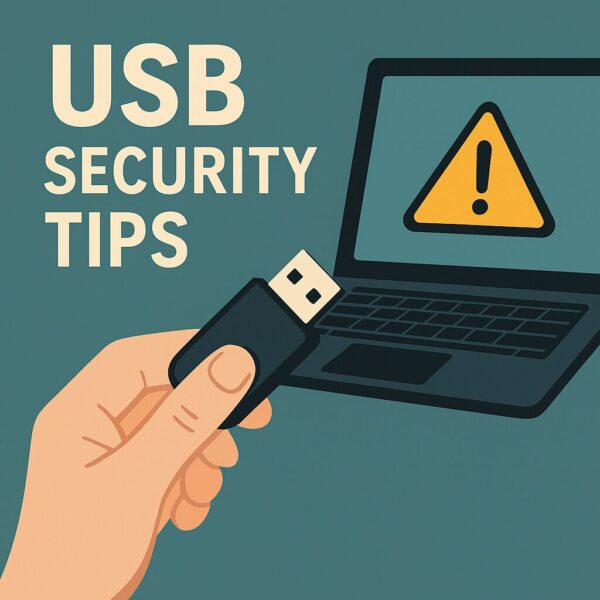
Do you often work in cafés, libraries, or shared offices with a USB flash drive or portable SSD attached to your laptop?
If so, your data may be at risk — even if everything looks normal.
From malware and data leaks to simple loss or theft, portable storage remains one of the most underestimated security threats for remote workers and small businesses.
One careless plug-in can put your system — and your company — in danger.
This updated 2025 guide explains how USB-borne infections happen and gives you 7 field-tested protections that work on modern Windows 11/10 devices. Every tip is beginner-friendly and usable in corporate environments.
- 1 How Do USB Devices Get Compromised?
- 2 Why It’s So Dangerous
- 3 7 Practical Ways to Use USB Drives and Portable SSDs Safely (2025)
- 3.1 1) Scan USB devices automatically — every time
- 3.2 2) Encrypt sensitive data (BitLocker To Go / VeraCrypt)
- 3.3 3) Turn off AutoPlay and block automatic execution
- 3.4 4) Use password-protected archives for sharing
- 3.5 5) Always eject safely
- 3.6 6) Be cautious on public networks and public PCs
- 3.7 7) Back up in multiple places — then keep the USB lean
- 4 Hidden Risks People Overlook
- 5 A Safe, Real-World USB Routine
- 6 FAQ (Updated for 2025)
- 7 Admin Corner (Optional, for Power Users/IT)
- 8 Final Reminder: Small Device, Big Risk
How Do USB Devices Get Compromised?
Even a “clean-looking” drive can carry hidden threats. The most common routes are:
Connecting to an untrusted or public computer
Shared PCs (schools, copy/print shops, hotel business corners) may auto-copy malware to any inserted drive. The next time you plug it into your own machine, the malware tags along.
Using someone else’s USB
Well-meaning colleagues can pass you a drive that already contains malicious scripts, droppers, or booby-trapped “documents.”
Opening suspicious files on the USB
Office macros, script-enabled PDFs, or disguised executables (e.g., .pdf.exe) can infect your system as soon as you double-click.
Pre-infected or malicious USB sticks
Cheap giveaways or “found” drives can be preloaded with spyware/ransomware — or even act as fake keyboards (so-called BadUSB/HID injection) to type commands on your PC.
Why It’s So Dangerous
- No internet required: USB-borne malware works offline and can bypass perimeter defenses.
- Fast and stealthy: Compromise can occur in seconds with little visual sign.
- Chain infection: One tainted drive can compromise multiple PCs in sequence — including well-locked-down ones.
Now let’s make your day-to-day use safe, practical, and repeatable.
7 Practical Ways to Use USB Drives and Portable SSDs Safely (2025)
1) Scan USB devices automatically — every time
On Windows 11/10, open Windows Security → Virus & threat protection → Scan options and run a Custom scan on the removable drive before opening files. In Virus & threat protection settings, keep Real-time protection, Cloud-delivered protection, and Automatic sample submission ON. Enable “Scan removable drives” if available.
Tip: Built-in Microsoft Defender is strong and well-integrated. If you prefer third-party suites, choose reputable vendors and enable their USB device scanning and device control features.
2) Encrypt sensitive data (BitLocker To Go / VeraCrypt)
For work documents or personal files, use BitLocker To Go (Windows Pro/Enterprise) or the free, cross-platform VeraCrypt. If you lose the drive, your data stays unreadable without the key.
Setup hint: BitLocker To Go works on common removable-drive formats (NTFS/FAT/exFAT). Use a strong passphrase and keep a recovery key in a password manager or printed and stored securely.
3) Turn off AutoPlay and block automatic execution
Modern Windows disables legacy AutoRun for USB by default, but AutoPlay (prompting actions when media is inserted) can still increase risk. Go to Settings → Bluetooth & devices → AutoPlay and turn it OFF, or set everything to “Take no action.” On managed PCs, admins can enforce Group Policy → Computer Config → Admin Templates → System → Removable Storage Access to block execution or force read-only.
Why: The safest posture is “nothing runs automatically.” You decide what opens, and when.
4) Use password-protected archives for sharing
When handing files to others, put them in a password-protected ZIP (7-Zip / WinRAR). Share the password separately. This limits casual browsing if your drive is borrowed or plugged into an unknown PC.
Tip: Don’t reuse archive passwords. Store them in a password manager and prefer long passphrases.
5) Always eject safely
Use Eject / Safely Remove Hardware before unplugging. Sudden removal can corrupt files (write caching) or damage the filesystem — especially on SSDs handling large transfers.
6) Be cautious on public networks and public PCs
Avoid plugging your drive into unknown or kiosk machines. If you must use shared PCs, enable a VPN, turn File and Printer Sharing OFF, and treat the USB as contaminated until you scan it back on your own computer. Drives with a physical write-protect switch are excellent for “receive-only” situations.
Charging safety: When charging phones from public USB ports, use a data-blocker/charge-only cable to prevent data handshakes (different threat, same principle).
7) Back up in multiple places — then keep the USB lean
Never make a single USB your only copy. Maintain secondary backups (cloud like OneDrive/Google Drive, or an external HDD/NAS). Automate nightly or weekly backups, and clear the USB after hand-offs to reduce exposure.
Hidden Risks People Overlook
- Using the same drive across home, office, and public machines
- Letting others borrow your USB “just for a minute”
- Using promotional or “found” drives of unknown origin
- Trusting that “nothing happened” because nothing popped up
Best practice: Assign one purpose per drive (e.g., “work hand-offs only”), scan often, and avoid devices from unknown sources.
A Safe, Real-World USB Routine
- At home/work, scan the drive with Microsoft Defender before use.
- Place files in password-protected ZIPs (or store on an encrypted drive).
- Do not plug into unfamiliar PCs; if unavoidable, treat the USB as suspect after.
- Always Eject / Safely Remove before unplugging.
- Back up to cloud or an external disk, then clean the USB.
Five small habits — a huge reduction in risk.
FAQ (Updated for 2025)
Q. What if the USB is already infected?
A. Disconnect from the internet, run a full Microsoft Defender scan, quarantine findings, and delete suspicious files. When in doubt, back up known-good data and reformat the drive (quick format is usually fine; full format if integrity is in question).
Q. Are free promotional USBs safe?
A. Assume no. Use only trusted-brand media purchased from reputable sources, or better: use your own encrypted drive.
Q. I forgot the password to my encrypted drive/archive.
A. Strong encryption can’t be bypassed. Keep recovery keys and passwords in a password manager. No password = no access.
Q. Can I block USB use on a company laptop?
A. Yes. IT can apply Device Control or Group Policy to block all removable storage or allow approved devices only. For small teams, start with “read-only for unknown USBs” and require encryption for write access.
Admin Corner (Optional, for Power Users/IT)
- Group Policy: Computer Config → Admin Templates → System → Removable Storage Access (block execute, set read-only, deny write).
- BitLocker To Go enforcement: Require encryption on removable drives before write access.
- ASR/Controlled Folder Access: In Microsoft Defender, enable Attack Surface Reduction rules and Controlled Folder Access to block untrusted apps (including from USB) from tampering with files.
- Block HID injection (BadUSB): Use device-installation restrictions to allow only approved hardware IDs; consider USB ports in charge-only mode on kiosks.
Final Reminder: Small Device, Big Risk
Most USB-related incidents aren’t sophisticated hacks — they’re accidents and bad habits. In a hybrid-work world, everyone shares responsibility.
Shift from “plug and play” to “plug and protect.” Your files — and your clients — will thank you.
✔️You might also find these helpful:
▶︎Windows 11 24H2 Update Breaks Internet: Causes & Fixes for Global Users
▶︎How to Fix Windows Update Error KB5063060 – Complete Guide
▶︎[Important] How to Extend Windows 10 Security Updates for Free Until October 2026


